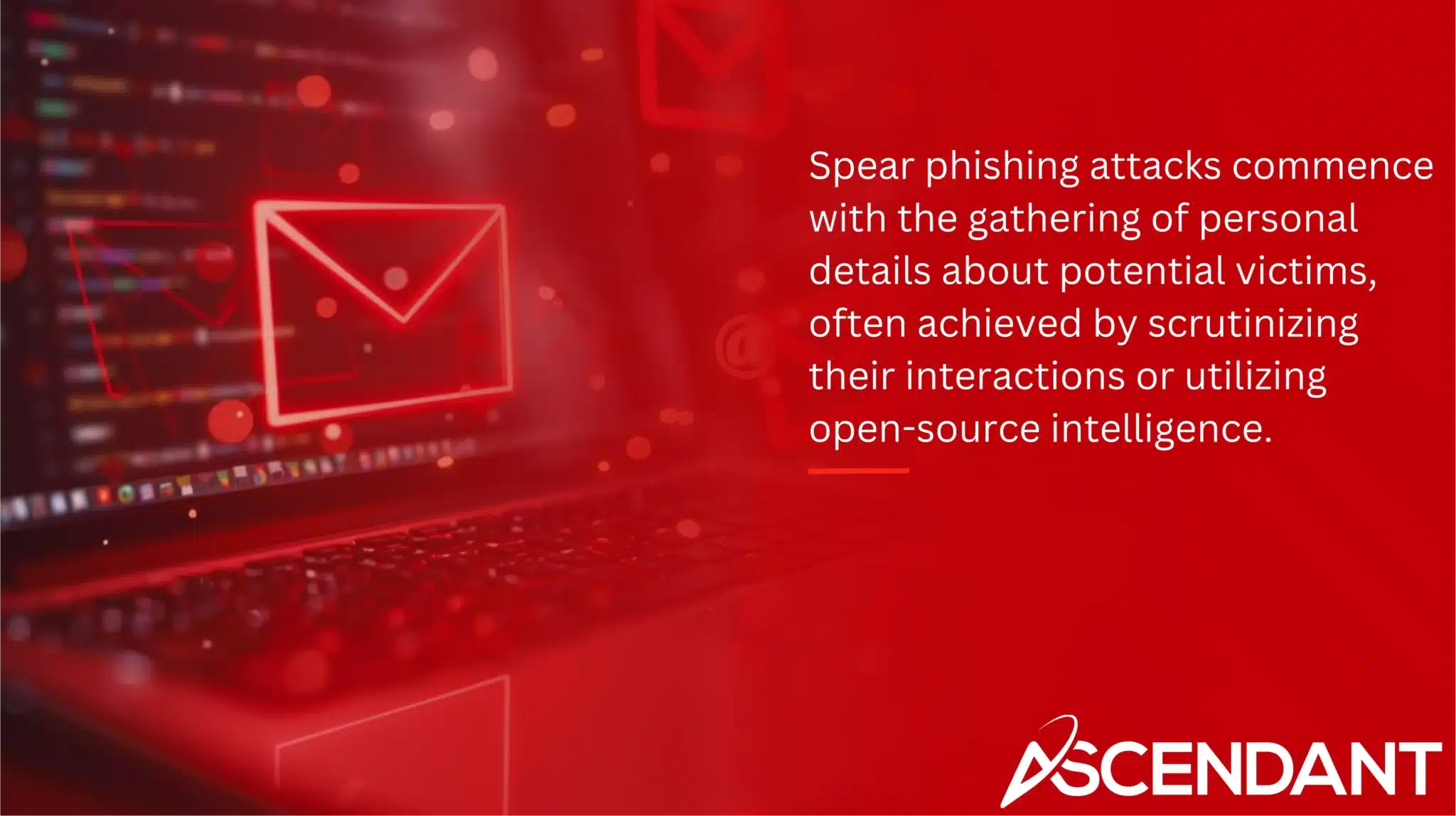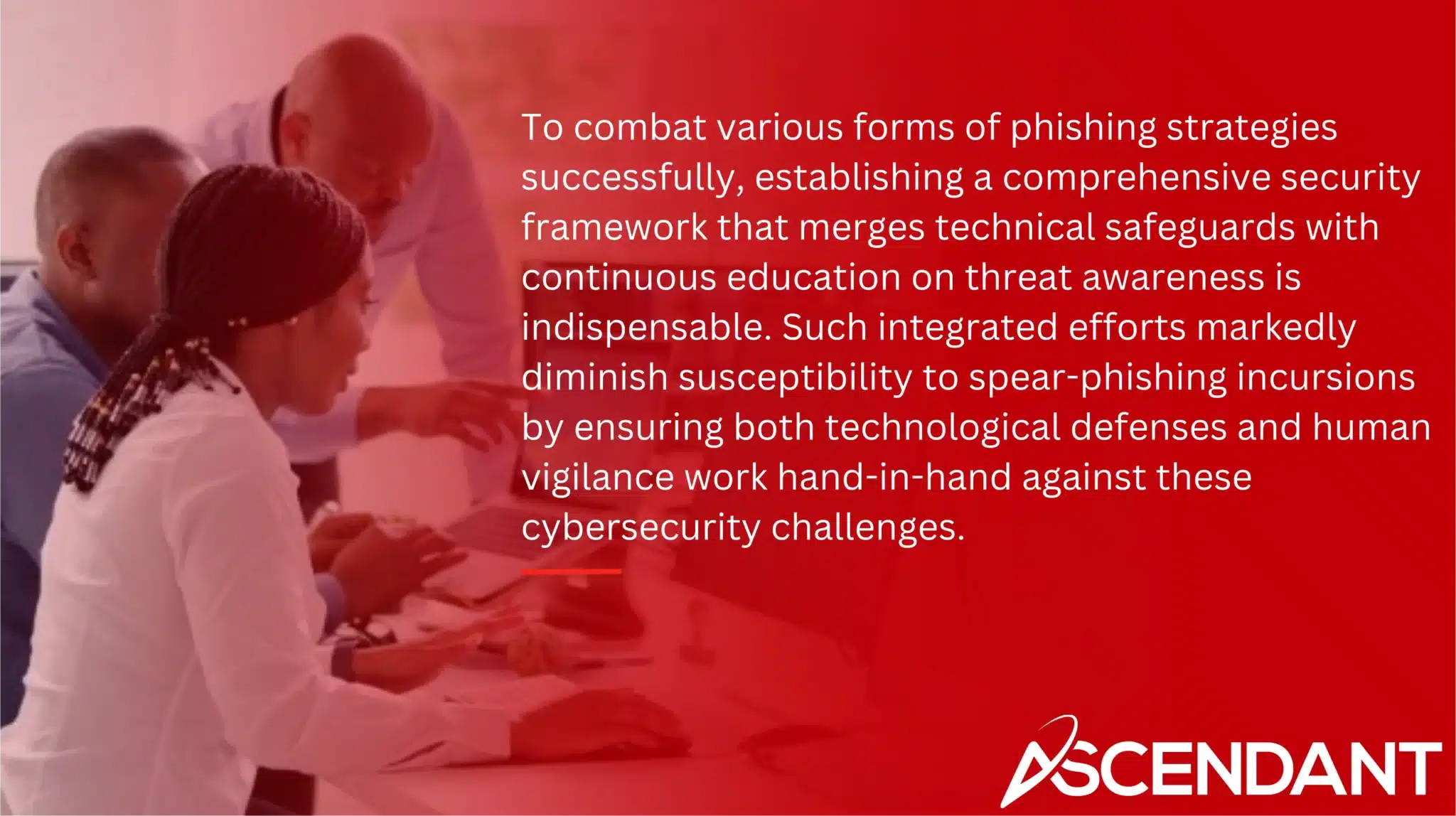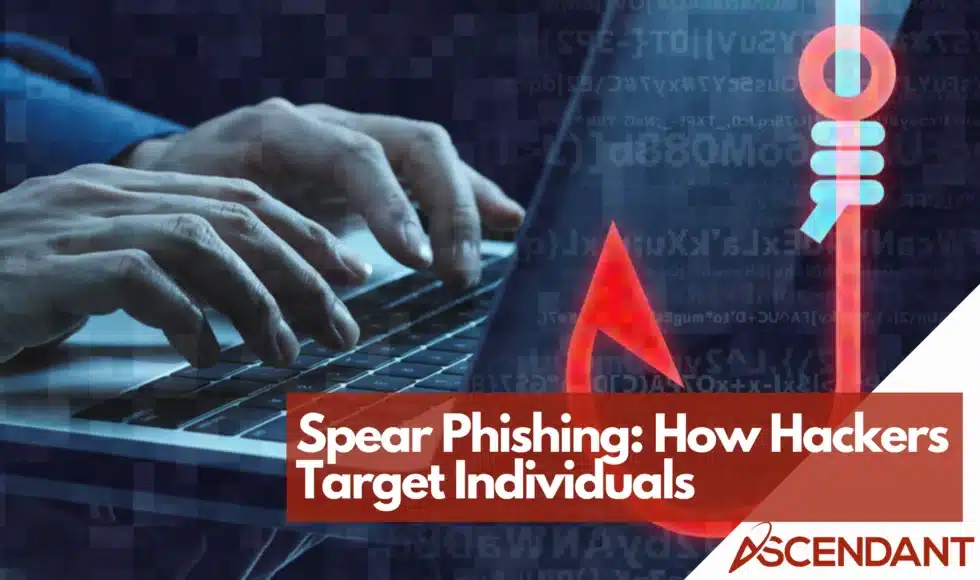Spear phishing is a targeted cyber attack that aims to steal sensitive information using personalized emails. Unlike generic phishing, these attacks use specific personal details to deceive victims more effectively. In this article, you will learn what spear phishing is, how it operates, and how to defend against it.
Key Takeaways
- Spear phishing is a targeted attack utilizing personalized information to deceive individuals into revealing sensitive data, often employing social engineering and impersonation tactics.
- The attack process involves gathering detailed personal information about the target, allowing attackers to craft convincing emails that manipulate victims into providing confidential information.
- Preventive measures include implementing multi-factor authentication, conducting regular security awareness training, and utilizing advanced email security solutions to block malicious communications.
Understanding Spear Phishing
Spear phishing represents a sophisticated form of cyber-attack designed to trick specific individuals into handing over sensitive information, employing personalized details such as an individual’s name and email address for enhanced belief. These attempts stand apart from general phishing efforts that cast a wide net with generic content. Spear-phishing is methodically tailored, necessitating greater effort but yielding potentially more perilous outcomes.
To bolster the credibility of their spear-phishing attempts, culprits utilize social engineering tactics alongside impersonations of credible entities. They cleverly craft misleading domain names and counterfeit hyperlinks to ensnare unsuspecting targets through emails laced with customized messages aimed at extracting private data under false pretenses.
The endgame for perpetrators launching spear-phishing attacks is obtaining classified information which paves the way for severe fraudulent activity or other forms of digital malfeasance. A critical defensive strategy against these targeted threats involves enhancing awareness among companies and individuals alike regarding how these infiltrations operate, ensuring better preparedness and security measures are in place to counteract them effectively.
How Spear Phishing Attacks Work

Spear phishing attacks commence with the gathering of personal details about potential victims, often achieved by scrutinizing their interactions or utilizing open-source intelligence. The success rate of these attacks is significantly increased when attackers possess a deep understanding of the target’s professional responsibilities and current activities, setting up a foundation for a successful spear phishing attack. Possessing this level of insight enables assailants to devise highly persuasive emails that have all the hallmarks of authenticity.
The information acquisition phase for launching a spear phishing attack may span several weeks or months as perpetrators invest significant effort into investigating their intended targets meticulously. By crafting messages tailored to specific facets such as the victim’s job description and known acquaintances, they lend an air of legitimacy to their fraudulent communications. By assuming the identity of someone familiar and trustworthy, they deftly coax victims into disclosing sensitive data.
Central to spear phishing are sophisticated social engineering tactics designed to take advantage of basic human emotions like trustworthiness and urgency—leveraging them in order to bend victims’ actions towards disclosure. These carefully constructed deceptions can be so convincing that distinguishing them from genuine correspondence becomes quite difficult. Hence making it hard for individuals targeted by these refined spear-phishing methods not only discern but also evade being ensnared effectively by such nefarious efforts at extracting sensitive information through deception.
Differences Between Phishing, Spear Phishing, and Whaling
Phishing attacks cast a wide net, aiming at vast numbers of people with nondescript communication. These phishing attempts bank on the expectation that even if only a small fraction respond, it will be enough. Typical scenarios involve receiving a phishing email pretending to emanate from reputable companies requesting personal information or login credentials. Often by the time a successful phishing attack is identified, significant damage has already occurred. To thwart these schemes effectively, one must promptly report any signs of phishing.
Spear phishing attacks differ as they are meticulously tailored and zero in on particular individuals or tight-knit groups. By weaving personal details into their ruse, attackers enhance credibility and improve their chances of duping the recipient into thinking the contact is trustworthy. Although this method demands greater effort from perpetrators, its precision leads to more fruitful outcomes.
Whaling attacks represent an intensified form of spear-phishing directed at senior executives or notable figures within organizations using bespoke emails that pertain to crucial business affairs for added authenticity. Thereby Bolstering believability amongst targets who hold influential positions within companies.
Real-World Examples of Spear Phishing Attacks
Throughout the years, numerous high-profile incidents of spear phishing have come to light, affecting distinguished entities including Home Depot, Anthem, Target, and JP Morgan. These targeted attacks haven’t just led to substantial financial damage but also compromised sensitive data, underlining the critical threat that spear phishing poses to both corporations and individuals.
The French cinema company Pathé stands as a prominent example of the severe consequences resulting from these sophisticated scams when they were swindled out of roughly €19,2 million through bogus wire transfers orchestrated by spear phishers. By impersonating top executives in emails sent to staff members who then followed directives for transferring money into deceptive accounts, showed how catastrophic such meticulously crafted frauds could be.
Despite accounting for a minuscule portion of overall email communication, spear phishing is behind approximately two-thirds of all breaches involving data security, underscoring their outsized impact on cybersecurity issues faced today. This reinforces why adopting rigorous defense strategies against these malicious endeavors remains crucial in thwarting cybercriminals specializing in this kind of espionage-esque brand of digital deception.
Identifying Spear Phishing Emails
Detecting spear phishing emails might pose a challenge, but certain telltale signs can provide clues. Look out for red flags such as unfamiliar email addresses from the sender, pressing subject lines that create a sense of urgency and dubious links or file attachments in the message body. It’s important to note that attackers frequently impersonate credible sources by falsifying both sender names and email addresses. This makes it vital to scrutinize the precise email address used.
Should an email seem questionable, heed your gut feeling and verify whether it is legitimate. Moving your cursor over any link within an email will reveal its true destination URL, which may indicate if you’re dealing with a deceptive website intended for phishing purposes. Using antivirus tools to check any received files before opening them can prevent inadvertently downloading harmful software.
It is crucial to approach all hyperlinks and documents shared via emails cautiously so as not to succumb to spear phishing schemes—particularly when such correspondences ask for confidential data or incite clicking on malicious links. Maintaining alertness plays a key role in safeguarding against these intricate forms of phishing attacks.
Prevention Strategies for Spear Phishing
Employing a blend of sophisticated security measures, adherence to proven practices, and employee education is pivotal in thwarting spear phishing attempts. Adding multi-factor authentication acts as a formidable barrier to unauthorized entry even when login credentials have fallen into the wrong hands. This additional verification measure fortifies security by preventing attackers from seamlessly accessing user accounts despite possessing their credentials.
Ongoing security awareness training plays an instrumental role in arming employees with the knowledge they need regarding cyber threats. By utilizing diverse educational methods, including organizational seminars and simulated phishing scenarios, workers are equipped to identify and evade potential spear phishing attacks effectively. Understanding how adversaries operate empowers staff members not only to safeguard themselves, but also reinforces the organization’s overall defense mechanisms.

To combat various forms of phishing strategies successfully, establishing a comprehensive security framework that merges technical safeguards with continuous education on threat awareness is indispensable. Such integrated efforts markedly diminish susceptibility to spear-phishing incursions by ensuring both technological defenses and human vigilance work hand-in-hand against these cybersecurity challenges.
The Role of Security Awareness Training
Implementing security awareness training is crucial in fortifying employees against spear phishing attacks. Such training equips staff with the skills to identify and report possible phishing attempts efficiently. By learning how to recognize and sidestep spear phishing endeavors, employees can greatly diminish the risk of experiencing data breaches.
To stay abreast of continually changing threats, it’s important for these programs to receive frequent updates. Maintaining current on instructional materials empowers personnel to be vigilant about the latest strategies used in phishing attacks, enabling them to act accordingly. Strengthening an organization’s cybersecurity education equips its workforce more robustly for impending digital dangers.
Allocating resources into security awareness initiatives safeguards not just online information, but also inhibits unsanctioned access within physical facilities. Adopting such a comprehensive stance toward protection guarantees that all employees are capable of confronting assorted challenges they might face in cyber as well as real-world settings.
Technological Solutions to Block Malicious Emails
Securing your email systems with sophisticated security measures is crucial in thwarting spear phishing attempts. These defenses should include immediate scanning of incoming emails to identify and stop malicious links and attachments from reaching users. Employ features such as URL inspection and sandboxing for attachments, which are pivotal for intercepting phishing attacks before they impact individuals.
For robust defense against phishing attempts, it’s necessary to deploy advanced algorithms that can thoroughly examine signals related to identity, behavior, and language usage. Incorporating multi factor authentication introduces an additional safeguard layer besides passwords alone. With this method implemented, even if credentials fall into the wrong hands, gaining unauthorized access becomes significantly more challenging for attackers.
Regularly updating your cybersecurity infrastructure is imperative in shielding against exploitable weaknesses that may be targeted by spear phishers. Continuous updates help maintain the effectiveness of security protocols in detecting new threats promptly thereby delivering comprehensive resistance to emerging spear phishing tactics aimed at compromising accounts or networks.
What to Do If You Fall Victim to a Spear Phishing Attack
In the event that you are targeted by a spear phishing attack, it’s imperative to act swiftly. Isolate your device from any network connections to stop the proliferation of possible malware. Alert your IT department without delay for them to conduct security protocols and eliminate any detected threats on your system. Adopting these immediate measures is vital in reducing damage if you have engaged with a malicious link.
Should you inadvertently provide login details on a deceptive site, proceed at once to update passwords for all authentic accounts. Consistent backups of data can serve as insurance against data loss due to malware stemming from a spear phishing attempt. Thus, securing copies of significant files is crucial for restoring information following an incident related to phishing.
To confirm whether requests received via email concerning sensitive matters are genuine, always opt for verification through direct phone calls. Taking such precautions plays an essential role in curtailing negative impacts and fortifying defenses against subsequent attacks.
Summary
Spear phishing is a highly personalized and sophisticated form of attack that poses significant risks to individuals and organizations. Understanding how these attacks work and how to identify them is crucial for protecting against them. Implementing prevention strategies, such as advanced security tools and regular security awareness training, can significantly reduce the risk of falling victim to spear phishing.
Staying vigilant and informed is the best defense against spear phishing attacks. By taking proactive measures and educating yourself and your employees, you can protect your digital assets and ensure a safer online environment.
Frequently Asked Questions
What is spear phishing?
Spear phishing is a highly targeted form of phishing in which attackers use personalized information to manipulate individuals into disclosing sensitive data.
It is essential to remain vigilant and verify email sources to protect against this threat.
How can I identify a spear phishing email?
To identify a spear phishing email, look for unusual sender addresses, urgent subject lines, and suspicious links or attachments.
These indicators can help protect you from falling victim to such targeted scams.
What should I do if I fall victim to a spear phishing attack?
If you fall victim to a spear phishing attack, it is crucial to disconnect your device from the internet immediately, notify your IT department, and change your passwords on legitimate sites to protect your information.
Additionally, ensure that your data backups are up to date.
How can I prevent spear phishing attacks?
To effectively prevent spear phishing attacks, implement advanced security tools and conduct regular security awareness training for employees.
This proactive approach will significantly enhance your organization’s defenses against such threats.
What is the difference between phishing, spear phishing, and whaling?
Phishing targets large groups with generic messages, while spear phishing involves tailored attacks on specific individuals. Whaling is a more targeted approach focused on high-level executives with highly customized content.
Each method escalates in specificity and potential impact, making awareness critical.


